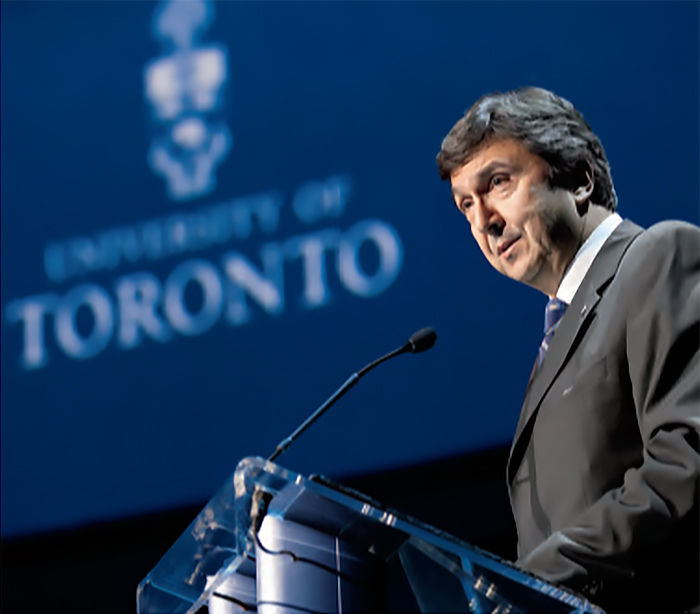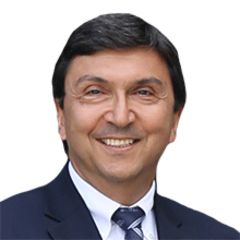On Nov. 20, the University of Toronto moved out of the quiet phase of its current fundraising efforts, and publicly launched a new campaign. The campaign’s theme is “Boundless” – reflecting the impact of the university’s alumni around the world, the scope and importance of the research done by today’s faculty, staff and students, and the potential of future generations of students. This is an edited version of David Naylor’s address at the launch event in Convocation Hall. In ensuing issues, U of T Magazine will explore the campaign and its goals in more detail.
When the University of Toronto opened its doors in 1827, the muddy little town of York was not even a city. How things have changed! Today, the university welcomes thousands of students from scores of countries to three distinctive campuses, more than a dozen hospitals and countless other sites of learning and discovery here at home and abroad. The little colonial outpost, moreover, is now a vibrant metropolis – and one of the world’s most diverse regions.
Some things, however, were already taking shape all those decades ago. We had students with high aspirations, remarkable professors and dedicated staff who then, as now, made it all possible. As well, even a hundred years ago, the support of our alumni and friends was beginning to lift this university. Without philanthropy, we would not have rebuilt University College after the Valentine’s Day fire of 1890, erected Convocation Hall in 1907 or opened Hart House in 1919. These foundations – laid by a confluence of talent, imagination, dedication and generosity – sustain us still. Upon them the university has built a truly global reputation and impact.
That reputation, I believe, arises first from the perceived quality of the university’s alumni. Our alumni reflect the strength of our students through the decades and their educational experiences. The university is truly fortunate to claim some 500,000 alumni in more than 170 countries, with concentrations in unexpected places from Hollywood to Hong Kong. There is no continent nor any walk of life where Toronto alumni are not in leadership roles.
Another key reputational factor is the perceived quality of our faculty, often viewed through the lens of research impact. Throughout the last century, our professors and their students, supported by our excellent staff, developed insulin and the electron microscope, discovered the chemical laser and stem cells, redefined literary criticism, theorized modern media and the digital age, roamed the world to uncover ancient civilizations, invented the glycemic index and pioneered in fields as diverse as organ transplantation and computer graphics.
Today, in total research output, the top three universities in the world are Harvard, Tokyo and Toronto. And when professors around the world are surveyed, time after time, in discipline after discipline, the University of Toronto is the Canadian leader and a serious global competitor.
In such a short amount of time, I cannot even begin to summarize the important discoveries, ideas and innovations that now stream rapidly out of your alma mater. What can perhaps be conveyed is why those efforts matter.
Imagine, for example, a future where prosthetic hips and knees are no longer necessary, and damaged organs can be repaired without drugs or transplants. Toronto has one of the world’s greatest concentrations of stem cell scientists, tissue engineers, transplant experts and brilliant clinicians in every discipline. The possibilities for advancing multiple fields of medical care are absolutely boundless.
Tens of millions of people around the globe are rising out of poverty each year – a wonderful trend. How will we meet their new energy demands without economic or ecological disruption? One intriguing option is to emulate plants and algae. Some scientists estimate that through artificial photosynthesis a bottle of water and sunshine could power a normal-sized home. If that doesn’t work, imagine transforming any roof or wall into an energy-harvesting surface with nano-engineered spray paint, or using cheap solar cells at home with advanced optics that double and triple the efficiency of current technologies. All these are currently areas for cutting-edge research at your university.
Other global challenges are much more complex. Across the world over a million people a week are moving from villages and farms into cities. The development of successful and sustainable cities is clearly one of the keys to humanity’s future. Even more fundamental to our future is protecting the potential of the world’s children. Whether from malnutrition in pregnancy, social deprivation or lost educational opportunities, tens of millions of children never have a chance to thrive and contribute.
Very few institutions in the world have the size, or the breadth and depth of excellence, to tackle these and other multi-dimensional problems facing humanity. The University of Toronto is one of those few. And that is why “meeting global challenges” is a broad theme of our new campaign.
The second broad theme is “preparing global citizens.” The university already offers its students a wonderfully diverse peer group and a dynamic urban context. We believe the research strength of our faculty, and their international reach, also aligns well with this theme. This research excellence translates readily into strong teaching and mentorship for students in graduate and professional programs. In addition, unlike some peer institutions, more than 90 per cent of the professoriate who have won major research distinctions are deeply engaged in teaching undergraduates. Toronto undergrads therefore benefit directly from the rigorous and original thinking that top scholars bring to the classroom.
Among the goals of the new campaign is funding to promote more small-group interaction between faculty and undergraduates, as well as more research opportunities for students during their baccalaureate years. If we can help our students develop a capacity for creative and critical thinking, that one skill, more than any other, will help them succeed no matter where they live and work. Consistent with the campaign theme of global citizenship, we also hope to support thousands more students to study abroad and pursue experiential learning opportunities in other nations.
As an aside, in these uncertain economic times, I understand why many are calling for “job-ready” graduates. However, the world is changing fast. We need to prepare our students for careers that have not even been invented. And, in the best case, we can also prepare them to be the leaders who invent those new careers.
The magic of our university environment, with its marriage of learning and scholarship, has been beautifully captured by University Professor Edward Chamberlin. After asking rhetorically what universities really do, Prof. Chamberlin answered: “We tell stories: old stories about evolution and the decline and fall of the Roman Empire, about the Big Bang and the Great War, about justice and freedom, supply and demand, economy and efficiency. And we make up new stories. We call the old ones teaching, and the new ones research.”
What I love about Ted Chamberlin’s description is its humanity and its emphasis on narrative. Yes, we publish a great deal, and I’m proud that we lead the country by a big margin in generation of intellectual property and spin-out companies – 18 last year alone. But none of this is really about papers, patents or profits. It’s about people – about those of us on faculty here, telling old stories, and with the help of our students and staff, writing new ones. And, much more importantly, it’s about our students, tomorrow’s alumni, preparing to write their stories in a world full of challenges that our generation has left them.
Ultimately, the support that so many alumni and friends have generously provided, and the support we are seeking in the years ahead, is itself in aid of a narrative – one of hope, of questioning, of imagining, and above all, unlocking the boundless potential of the next generation to make the world a slightly better place.
Sincerely,
David Naylor
Visit President Naylor’s blog
Recent Posts
U of T’s 197th Birthday Quiz
Test your knowledge of all things U of T in honour of the university’s 197th anniversary on March 15!
Are Cold Plunges Good for You?
Research suggests they are, in three ways
Work Has Changed. So Have the Qualities of Good Leadership
Rapid shifts in everything from technology to employee expectations are pressuring leaders to constantly adapt






